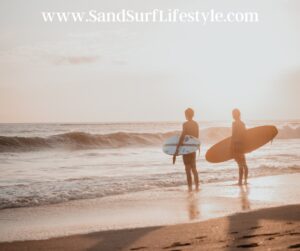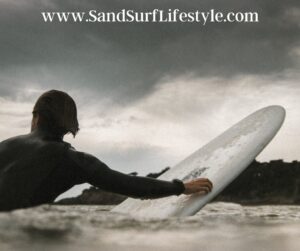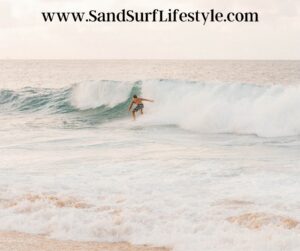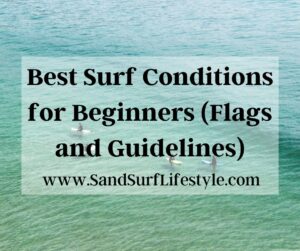Best Surf Conditions for Beginners (Flags and Guidelines)
Finding the best conditions can be tricky for a beginner. Those waves can be intimidating, below is a basic guide to get started.
Best Surf Conditions for Beginners (Flags and Guidelines)
- Waves to Look for
- Offshore Winds
- Comfort is Important
- Groundswells & Peeling Waves
- Etiquette
The best surfing conditions for beginners are smaller waves and waves formed by white water. Also, you should keep an eye out for the type of wind that is blowing when you are scouting a surf spot. Offshore winds are ideal. Watching for groundswells and peeling waves will build your skills faster and smoother, also be sure to keep surf etiquette in mind. As a beginner surfer, a great way to get a general idea of the expected conditions of an area is to ask the locals and other surfers for tips.
Keep an eye out for these ideal conditions, however, they may not present themselves to you often. In that case, remain cautious and aim for at least a few of these conditions. By staying within this range you will build your skills without putting yourself in harms way. Safety is important with this sport because you are in the ocean. Out there things can go wrong fast.
1. WAVES TO LOOK FOR
 Generally, the best waves for beginners are smaller waves, between 1.5 ft – 2ft. A great way to measure the height of a wave is to use your body. Roughly a one-foot wave is similar to the distance from your knee to your thigh and a two-foot wave is from your knee up to your chest. Keep these measurements in mind when you are judging waves and it will seem less intimidating.
Generally, the best waves for beginners are smaller waves, between 1.5 ft – 2ft. A great way to measure the height of a wave is to use your body. Roughly a one-foot wave is similar to the distance from your knee to your thigh and a two-foot wave is from your knee up to your chest. Keep these measurements in mind when you are judging waves and it will seem less intimidating.
Another way to judge waves suitable for beginners is to look for white water. White water is the foaming small rolling waves that are formed when a wave breaks. These are great gentle waves that will allow new surfers to get used to popping up and catching waves. They are good for learning how to make your bodies do what you need to do to stay on your surfboard and then how to control your surfboard.
2. OFFSHORE WINDS
Offshore winds are winds that blow from inland out into the ocean. This is the wind you want when you go out to surf. You want this type of wind to make your waves because it makes for the cleanest waves. Making surfing smooth and pleasant, not choppy. Offshore winds also make for easier to read waves so you can find the best waves to catch easier.
3. COMFORT IS IMPORTANT
The temperature of the water you are surfing in is important too. Because it’s comfortable and you can focus more on what you are doing. So try surfing on a sunny day when the temperature is between 24-28 degrees Celsius or 77-83 degrees Fahrenheit. The water will be nice and warm then at roughly 22-24 degrees Celsius or 71-75 degrees Fahrenheit. Also, a cloudless day is best with those ideal offshore winds, but make sure to aim for light wind.
4. GROUNDSWELLS & PEELING WAVES
A groundswell is made by winds from a deep low-pressure system that develops and rages out at sea. The wind from the storm creates waves that will eventually join together with other waves to make bigger waves. The farther from the storm the waves travel, the more groomed/organized they become. Also, you want to keep an eye out for waves that peel. Meaning they break in one spot and keep peeling giving you more time to enjoy the wave and build up your skills.
Want to get better at surfing? Here are some exercises beginner surfers can do.
5. ETIQUETTE

There is etiquette that comes into play with surfing. Dropping in is one of the big bits of bad etiquette. There is a right of way when it comes to surfing, just like there is a right of way when you drive on the freeway. The surfer who has the biggest chance at enjoying most of the wave generally has the right of way.
However, sometimes another surfer may be to their feet before you. In this case, even if you have the best chance at enjoying most of the wave the right of way goes to the surfer standing up first. Sometimes you may accidentally drop in on another surfer, it sometimes happens just say honest and admit your mistake with an apology.
In some situations, the other surfer you are dropping in on will whistle at you. Indicating you don’t have the right of way. You can amend your mistake when you realize it, sometimes even before you disrupt the other surfer’s ride. Simply take a smooth leftover wave leaving that spot for the surfer with the ride of way. Sometimes even you may find yourself having to wait in a surf line to catch a wave.
Also, communicating and being verbal with other surfers is important. Let others know your intentions go a long way. If you do fall off your board too close to another surfer. Holding onto your board is key. Because if you let it fly, it’s heavy and could hurt someone. Also if you let your board fly off you can potentially break or lose your board.
QUICK TIP: Once you’re done surfing rinse your surfboard off. The saltwater can do damage to your board.
 Surfing is exhilarating, however, it is a sport that should not be approached lightly. Take a moment and really think about which surfing location you want to visit, do some research. Also, keep an eye on the weather. Because a fun day at the beach can easily turn deadly if you find yourself in a storm or taken away by a wave. Take it slow and steady to build up your skills and eventually you will find yourself at a high enough level to take on those big waves.
Surfing is exhilarating, however, it is a sport that should not be approached lightly. Take a moment and really think about which surfing location you want to visit, do some research. Also, keep an eye on the weather. Because a fun day at the beach can easily turn deadly if you find yourself in a storm or taken away by a wave. Take it slow and steady to build up your skills and eventually you will find yourself at a high enough level to take on those big waves.
Get started in the white water and begin to hone your abilities there. Also, although you are a beginner, make sure to mind your manners in the water. Because you never know what skills and tips veteran surfers may be able to teach you. If you keep at it, you will find yourself being able to read the water and you will be able to seek out the surfing conditions which are not only ideal for you but also the most fun.
Related Questions:
What conditions make for the best surfing, high or low tide?
The best way to tell where the conditions are ideal is to ask a local. Sometimes changing sandbanks can affect how the waves are breaking too, which is constantly changing.
Why wax your surfboard?
Wax on your surfboard will help you stay on. The wax gives you something to help you grip. The temperature of the water you are surfing in will be the biggest factor when deciding how much to apply.
How should you store your surfboard?
A padded board bag will go a long way to protect your surfboard. If you find yourself buying more than one surfboard there is always the surfboard rack option, keep in mind though you don’t want the surfboards clanging against one another or against the rack. You may want to apply some foam and soft carpeting on the bottom.
Sources:
https://houseofsurf.co/best-surf-conditions-for-beginners/
https://barefootsurftravel.com/livemore-magazine/surf-ethics-10-rules-beginner-needs-know
https://www.islesurfandsup.com/blog/caring-for-your-surfboard/

Please note: This blog post is for educational purposes only and does not constitute legal or medical advice. Please consult a legal expert or medical professional to address your specific needs.

